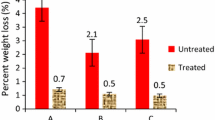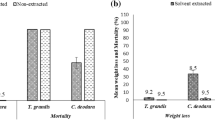Abstract
Mindi (Melia azedarach) wood with density of 0.43 g/cm3 from Indonesia and sugi (Cryptomeria japonica) wood with density of 0.34 g/cm3 from Japan were treated with borax preservative, acetylation, polystyrene, and smoke. Treated and untreated wood samples were tested for resistance against subterranean termite (Coptotermes curvignathus) and dry wood termite (Cryptotermes cynocephalus) in the laboratory according to Indonesian standards. In addition to determining resistance of treated woods to termite attack, this work also evaluated termite feeding rates. The results showed that mindi has better resistance to subterranean and dry wood termite attack than sugi. All treatments effectively increased resistance to subterranean and dry wood termite attacks as shown by treated wood samples having less weight loss, higher resistance class, higher termite mortality, and a lower termite feeding rate compared to untreated wood. Daily termite feeding rate of untreated mindi was 50.3 μg/termite and sugi 95.8 μg/termite, the feeding rate of sugi was higher than mindi probably because sugi has a lower density and contains early wood, which both make termite feeding activity easier. The wood treatments effectively decreased the daily feeding rate of the termites.
Similar content being viewed by others
References
Anonymous (2005) Pelatihan Persemaian Mindi (Mindi Nursery Training). RUAS, Majalah Kehutanan dan Lingkungan (Magazine of Forestry and Environment), Perum Perhutani Unit 1 Central Java, Edition 05/V/November 2005, p 17
Arango RA, Green F, Hintz K, Lebow PK, Miller RB (2006) Natural durability of tropical and native woods against termite damage by Reticulitermes flavipes (Kollar). Int Biodeterior Biodegrad 57:146–150
Arinana, Tsunoda K, Herliyana EN, Hadi YS (2012) Termite-susceptible species of wood for inclusion as a reference in Indonesian Standardized laboratory testing. Insects 3:396–401
Devi RR, Ali I, Maji TK (2003) Chemical modification of rubber wood with styrene in combination with a crosslinker: effect on dimensional stability and strength property. Bioresour Technol 88:185–188
Forest Research and Development Agency (2001) Mindi (Melia azedarach L.). Ministry of Forestry, Jakarta
Hadi YS, Darma IGKT, Febrianto F, Herliyana EN (1995) Acetylated rubberwood flakeboard resistance to biodeterioration. For Prod J 45(10):64–66
Hadi YS, Nawawi DS, Herliyana EN, Lawniczak M (1998) Termite attack resistance of four polystyrene impregnated woods from Poland. For Prod J 48(9):60–62
Hadi YS, Westin M, Rasyid E (2005) Resistance of furfurylated wood to termite attack. For Prod J 55(11):85–88
Hadi YS, Nurhayati T, Jasni J, Yamamoto H, Kamiya N (2010a) Smoked wood as an alternative for wood protection against termites. For Prod J 60:496–500
Hadi YS, Nurhayati T, Jasni Yamamoto H, Kamiya N (2010b) Smoked wood resistance against termite. J Trop For Sci 22(2):127–132
Hadi YS, Nurhayati T, Jasni J, Yamamoto H, Kamiya N (2012) Smoked wood resistance to subterranean and dry wood termites attack. Int Biodeterior Biodegradation 70:79–81
Hadi YS, Arinana A, Massijaya MY (2014) Feeding rate as a consideration factor for successful termite wood preference tests. Wood Fiber Sci 46:590–593
Hadi YS, Rahayu IS, Danu S (2015) Termite resistance of jabon wood impregnated with methyl methacrylate. J Trop For Sci 27:25–29
JIS (Japanese Industrial Standard) (2004) Test methods for determining the effectiveness of wood preservatives and their performance requirement. Japanese Standard Association, Tokyo
Ministry of Forestry (2014) Forestry Statistics of Indonesia 2013. Jakarta
Praptoyo H (2010) Sifat anatomi dan sifat fisika kayu minda (Melia azedarach Linn) dari hutan rakyat di Yogyakarta (Anatomical and physical properties of mindi wood from community forest in Yogyakarta). Jurnal Ilmu Kehutanan IV(1):21–27
Rowell RM (2008) Use of acetylation for production of decay resistant wood composites. Proceedings of international symposium on wood science and technology, IAWPS2008, Harbin, 27–29 Sept 2008, pp 401–402
SNI (Standar Nasional Indonesia; Indonesian National Standard) (2006) Wood and wood products resistance test to wood destroying organism. Indonesian National Standard Bureau, Jakarta
Stan I (2009) The Anatomical Study of the Stem at Two Gymnosperme Species (Cryptomeria japonica Don, Ginkgo biloba L.). Bull UASVM Hortic 66(1):620–624
Yoshimura T, Tsunoda K (2005) Termite problems and management in Pacific-Rim Asian region. IAWPS2005 international symposium on wood science and technology, Vol. I: Oral Presentation, Pacifico, Yokohama 27–30 Nov 2005, pp 316–317
Acknowledgments
The authors would like to express their great appreciation to the Indonesian Ministry of Education and Culture, which gave sponsorship for conducting the research through Competency Research Grant, and to Ms T Nurhayati and Ms Jasni at Forest Products Research Institute in Bogor Indonesia, Dr. H Yamamoto at Nagoya University and Mr N Kamiya at Massiki Lumber Co Ltd in Japan for supporting this research.
Author information
Authors and Affiliations
Corresponding author
Rights and permissions
About this article
Cite this article
Hadi, Y.S., Massijaya, M.Y., Hermawan, D. et al. Feeding rate of termites in wood treated with borax, acetylation, polystyrene, and smoke. J Indian Acad Wood Sci 12, 74–80 (2015). https://doi.org/10.1007/s13196-015-0146-2
Received:
Accepted:
Published:
Issue Date:
DOI: https://doi.org/10.1007/s13196-015-0146-2




